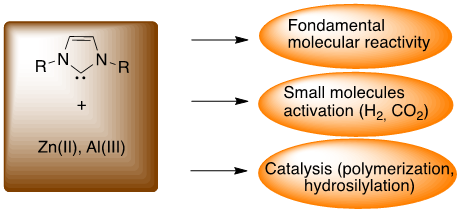Abstract:
Over the past twenty years, N-heterocyclic carbenes (NHCs) have become an ubiquitous class of supporting ligands in coordination chemistry with countless successful applications of the derived NHC metal complexes in various areas. Due to their exceptional -donating properties and steric tunability, NHC-bonded metal complexes usually exhibit an inert NHC-M bond yielding enhanced stability: this has opened the way to the development of robust NHC-incorporating metal compounds that often feature an increased activity/selectivity in catalysis and may exhibit novel fundamental reactivity. Though less investigated thus far, combining NHCs with main group elements and/or oxophilic metal centers may also be the source of unusual reactivity and/or unprecedented activation chemistry.
We are interested in the NHC coordination chemistry of oxophilic and high-oxidation state metal centers (which are frequently cheap metal sources) for fundamental reactivity/activation studies and the use of the derived complexes in sustainable catalysis. In the present seminar, discrete NHC-Zn(II) and NHC-Al(III) species are described along with their reactivity trends. Such simple coordination complexes are shown to be of rather broad interest since they may be involved in various chemical transformations ranging from unusual fundamental reactivity (rearrangement processes), small molecules activation (H2, CO2) and homogeneous catalysis (cyclic esters/carbonates polymerization, hydrosilylation catalysis). All these aspects will be discussed.

Selected refs: Chem. Commun. 2010, 46, 2480; ChemCatChem 2014, 6, 1357; Chem. Eur. J. 2015, 21, 17959; Organometallics 2016, 35, 1726; Chem. Eur. J. 2017, 23, 5509; Chem. Eur. J. 2017, 23, 15908
